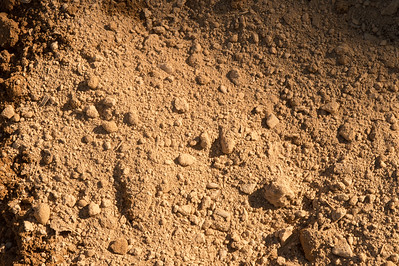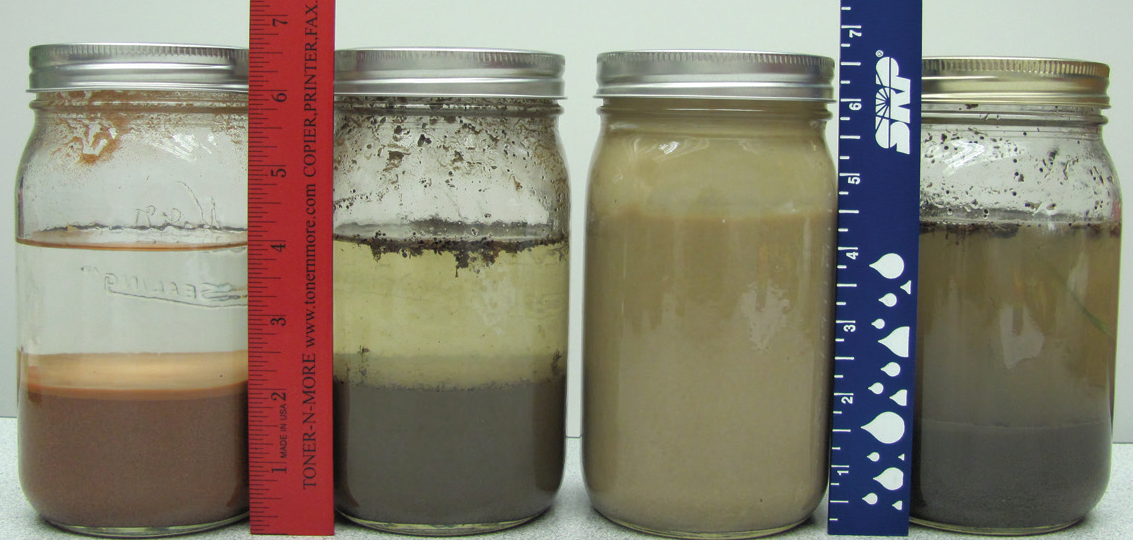Soil is the foundation of agriculture. Farmers know that different soils are suitable for different crops, but how do they recognize what type of soil they have? Texture is an easily recognizable property that informs farmers about how to manage their soils. Soil texture cannot be changed, and it affects the movement of water and nutrients in the root zone of plants. Clayey soils hold water and nutrients, while sandy soils drain and dry out quickly. Farmers will make different decisions about irrigation, tillage, and what type of crop to plant based on the texture of their soil. With some practice anyone can learn to recognize different soil textures by feel.
Soil is made up of four components: air, water, organic matter, and mineral matter. The mineral component, made of tiny particles of rock, determines the texture of the soil. Soil particles are categorized according to their size as sand, silt, or clay. Sand is the largest category, including particles that measure 2.0 to 0.05 mm. Silt particles measure between 0.05 and 0.002 mm, and clay particles are less than 0.002 mm. (Most soils are a mixture of sand, silt, and clay.) When the three particles are present in approximately equal amounts, the soil is considered a loam. A soil that has more sand in it is a sandy loam, one with more silt is a silty loam, and one with more clay is a clay loam. The Soil Texture Triangle provides standardized soil textural classes based on the relative quantities of sand, silt, and clay particles in a soil.
The first activity in this lesson is a “hydrology test” that uses water to separate soil particles. This is a quick, simple method to assess soil texture. Sand is the largest, heaviest, and most dense particle, so it will settle out of the water first—within one minute. Silt, the next largest particle, will settle out in three to four hours, and clay will take days to completely settle. The layers may be easy or difficult to see, depending on the mineral composition of the soil. Soil color is not directly related to texture. Some red soils have a greater fraction of clay particles than others. Scientific laboratories shake soil samples in water for 24 hours to ensure that tiny clay particles are thoroughly separated. Two minutes of shaking is sufficient for a classroom experiment, and alum can be added to improve separation. Organic matter will separate out as debris floating on top of the water. Soil texture is based on the mineral component of the soil and does not include organic matter.
When texturing soil samples by hand, students should use the following criteria: sand feels gritty; silt feels smooth, soft, and somewhat slick, like the smooth silkiness of baby powder; clay feels sticky and often stains the fingers. Soil samples containing a lot of clay can be pressed together through the thumb and forefinger to create a "ribbon" of soil. If the soil doesn't contain much clay, the ribbon will break before it gets very long. Clay soils stick together. This can also be demonstrated by forming a ball out of the soil and testing how much pressure is needed to break the ball-sandy soils will break apart easily, clay soils will resist breaking. many people are familiar with pottery clay. Clay soil is stickier than pottery clay but will hold together in a similar fashion. You cannot determine soil texture by color or where it is found in the soil profile, but by feeling the soil or conducting the simple hydrology test described here, you can easily identify the texture of a soil.

